470. The troopers being sufficiently
instructed to manage their horses and use their arms, are passed to the
school of the troop. The object of this school is to teach them to
exercise properly together, and to execute all the movements of the
troop, whether in column of platoons, or in line.
Each movement, after having been correctly executed by the right, is repeated by the left.
When the movements are all executed at the walk, the
instructor causes them to be repeated at the trot, requiring always the
same simultaneous action, and the same precision. This gradation is
also followed for exercise at the gallop; but the horses should not be
kept long at this gait.
The troop is composed of all the troopers of a
single company; for exercising it is formed in two ranks, and divided
into two platoons. The troop is one half of the squadron, and
when it forms a part of the squadron constituting one of the divisions,
the officers and non-commissioned officers are posted as directed for a
squadron in line; but where the troop acts singly, as will be supposed
in the school of the troop, the officers and non-commissioned officers
take posts as directed for a company acting singly. (See No. 17.)
For the school of the troop, the troopers are under arms; if armed with the carbine it is always slung.
471. The troop being formed in two ranks, at open order, the
1 If the platoons are small, or if the instructor wishes to
exercise the troop in the school of the squadron, he mny cause it to be
formed in a single rank.
384 MANUAL FOR VOLUNTEERS AND MILITIA.
troopers and file-closers at the head of their horses, the chiefs of
platoon mounted, facing the platoon, at ten paces from and opposite the
centre, the captain commands:
1 ATTENTION. 2. Right-DRESS. 3. FRONT.
He then commands:
In each platoon- and in each rank- Count by fours.
At this command, the troopers count off in both platoons at once, commencing on the right of each rank.
The captain then gives the command mount, which is executed as explained in the school of the trooper, No. 407.
At the command form - RANKS, the chiefs of platoon move forward, face
to the front by turning to the right about, and place themselves before
the centre of their platoon, the croup of their horses one pace from
the head of the horses of the front rank. The fileclosers follow the
rear rank.
General principles of alignment.
472 The troopers, in order to align themselves, should regulate their
shoulders upon those of the men on the side of the alignment, and fix
the eyes upon the line of the eyes, so as to perceive the breast of the
second trooper of their rank on the alignment; for this purpose, they
should turn the head, remaining square upon their horses, feel lightly
the boot of the man on the side of the alignment, and keep the horses
straight in the ranks, that all may have a parallel direction.
The troopers of the rear rank, independently of the alignment, should
be exactly behind their file-leaders, and in the same direction, taking
care to preserve the distance of two feet from head to croup.
Successive alignment of the files in the troop.
473. The two files of the right (or left) are moved
forward ten paces, and aligned parallel to the troop by the commands:
SCHOOL OF THE TROOP. 385
1. Two files from the right (or left) forward. 2. March. 3. HALT. 4. Right (or left) - DRESS. 5. FRONT.
The captain then commands:
1. By file right (or left) - DRESS. 2. FRONT.
At the command dress, each file moves forward in succession and
steadily, the troopers turning the head to the right, and taking the
last steps slowly, in order to arrive abreast of the files already
formed without passing beyond the alignment, observing then to halt,
give the hand, relax the legs, and keep the head to the right until the
command front .
Each file executes the same movement when the preceding one has arrived
on the base of alignment, so that only one file may align itself at the
same time.
At the command front, turn the head to the front. The captain gives the command front when the last file is aligned.
When the troopers execute these alignments, this instruction is
repeated in giving the two files of the right an oblique direction. For
this purpose, the two files having marched forward four paces, as has
been prescribed, execute a half tum to (he right (or left), and march
six paces in this new direction.
The troop being unmasked, the remainder of the movement is executed by
the same commands, and on the same principles as in the last ease; each
file, as it arrives nearly opposite the place it is to occupy, executes
a half turn to the right (or left), so that having left the troop by
one straight line, it arrives upon the new alignment by another.
474. The two files of the right, or left, are made to rein back four
paces, and align themselves parallel to the troop, and opposite the
place they occupied in it, by the commands:
1. Two files from right (or left) backwards. 2. MARCH. 3. HALT. 4. Right (or left)-DRESS. 5. FRONT.
The captain then commands:
1. By file-right (or left), backward-DRESS. 2. FRONT.
386 MANUAL FOR VOLUNTEERS AND MILITIA.
At the command dress, each file reins back in succession, keeping
perfectly straight, the troopers turning the head to the right, and
passing a little to the rear of the files already formed, in order to
come up abreast of them by a movement to the front, which renders the
alignment more easy.
The troopers of the front rank rein back slowly, those of the rear rank
regulate themselves upon their file-closers, preserving always their
proper distance.
At the command front, turn the head to the front.
475. The alignment is then executed by twos (or by fours). For this
purpose, the two or four files of the right move forward as has been
prescribed, and the captain commands:
1. By twos (or by fours)-right (or left)-DRESS. 2. FRONT.
At the command dress, the files align themselves in succession by twos
(or by fours), following the principles prescribed for the alignment by
file, being particular to set out and arrive upon the alignment
together.
At the command front, turn the head to the front.
Alignment of the troop.
476. The captain, after having placed the right
guide, so that no trooper will be compelled to rein back, commands:
1. Right - DRESS. 2. FRONT.
At the command right dress, all the troopers align themselves steadily but promptly to the right.
The troop being aligned, the captain commands:
FRONT.
The captain causes three different alignments to be
executed by the left, following the same principles, but by inverse
means.
To open and close the ranks.
477. To open the ranks, the captain commands:
SCHOOL OF THE TROOP. 387
1. Rear rank open order. 2. MARCH 3. Right - DRESS. 4. FRONT.
At the command march, the front rank remains immoveable, the rear rank
reins back six paces, each trooper preserving the direction of his
file-leader. The file-closers rein back until they are six paces from
the rear rank. The chiefs of platoon move forward six paces, and
face the centre of the platoons by turning to the left about.
At the command right dress, the rear rank dresses to the right. At the command front, the head is turned to the front.
To close the ranks the captain commands:
1. Rear rank close order. 2. MARCH 3. Right - DRESS. 4. FRONT.
At the command march, the rear rank closes upon the front to the
distance of two feet, each trooper taking care to preserve the
direction of his file-leader. The chiefs of platoon resume their places
by a turn about to the right, and the file-closers take their proper
distances from the rear rank.
At the command right dress, the troop is aligned to the right, At the command front, the head is turned to the front.
To rein back the troop.
478. The troop being at a halt, the captain commands:
1. Troop backwards. 2. Guide right (or left). 3. MARCH.
At the command
march, all the troopers rein back at once, regulating their movements
by those of the right guide.
When the troop has reined back some steps, the captain commands:
1. Troop. 2. HALT. 3. Right (or left)-DRESS. 4. PRONT.
To break the troop by file.
479. The troop being in line, the captain commands:
1. By file. 2. MARCH
388 MANUAL FOR VOLUNTEERS AND MILITIA.

(Fig. 109). At the command by file, the
troopers of the first file (front and rear rank) gather their horses,
and the others in succession as soon as the file on the right is in
motion. The chief of the first platoon, f'ollowed by the first
sergeant, or guide of the right, posts himself in front of the first
file.
At the command march, the chief of the platoon, the guide, and the
first file on the right moves straight to the front; they are followed
by the next file; each files moves off when the haunches of the horses
of the rcar rank man which has broken, arrives at the head of the
horses of the front rank; each file marches six paces straight to the
front, makes a quarter-turn to the right, and marches in the new
direction until it reaches its place in the column, when it makes a
quarter-turn to the left.
The chief of the second platoon breaks with his first file, keeping
abreast with, and one pace to his left. The first lieutenant is in the
rank of fileclosers, opposite the centre of the column, and the second
sergeant or guide of the left, follows the last file.
To break the platoon by the
SCHOOL OF THE TROOP. 389
left, the movement is executed following the same principlcs, but by inverse means, at the commands:
1. By the left file. 2. MARCH.
Direct march in column by file.
480. The troopers should keep their horses straight, anu march at a
free and equal gait; they should keep their eyes to the front, and
continue in the direction of the column, so as to perceive only the
trooper who marches before them, to march at the same gait with him,
preserving always the distance of two feet from head to croup, that his
own horse may not tread upon the heels of the horse in front. This
distance should be recovered gradually when lost.
The column changes direction to the right or left, as prescribed No. 410.
To halt the column, the captain commands:
1. Column. 2. HALT.
At the command halt, the troopers stop together in the direction of
their file-leaders and at their distances, taking care to prevent the
horses from stepping back.
To move off, the captain commands:
1. Column forward. 2. MARCH.
At the command march, the troopers move off together.
The column being at a halt, if the captain wishes to commence the move
at a trot, he conforms to what is prescribed No. 423. In this case the
chiefs of platoon move off promptly at the trot, that the troopers in
their rear may take this gait at once, without marching first at a
walk.
Individual oblique march.
481. The column marching by file, the captain commands:
1. Left (or right) oblique. 2. MARCH
At the command march, each trooper executes a quarter turn to
390 MANUAL FOR VOLUNTEERS AND MILITIA.
the left, and moves forward in his new direction, all following
parallel lines, and regulating themselves towards the right, in order
to keep on the same line, and to preserve their distances on that side.
To return to the primitive direction, the captain commands:
FORWARD.
At this command, the troopers return to the original direction, by a
quarter tum to the right, in advancing, and move forward in the
direction of their file-leaders.
The troop marching in column by file, to form it to the front, to the left, or on right, into line.
482. The column marching right in front, to form it to the front into line, the captain commands:
1. Front into line. 2. MARCH. 3. Right - DRESS. 4. FRONT.
(Fig. 110.) At the command march, the first file continues to march
straight forward. The others immediately commence obliquing to the
left, march in their new direction, and each file makes a quarter tum
to the right on coming opposite to the place he is to occupy in the
troop. When the first file has marched twenty paces, the chief of the
first platoon commands halt. At this command, it halts square to the
front, the guide on the right of the front rank man; the other files
come up in succession on the left of the first, and dress to the right.
At the command front, turn the head to the front.
The captain gives the command right-dress, immediately after halt, and commands front when the last file is aligned.
The column marching left in front, the movement is executed following the same principles, but by inverse means.
483. The column marching right in front, to form it into line upon its left flank, the captain commands:
1. Left into line. 2. MARCH. 3. Left - DRESS. 4. FRONT.
(Fig. 111.) At the command march, the first file turns to the left, and
moves straight forward; the other files continue to march
SCHOOL OF THE TROOP. 391
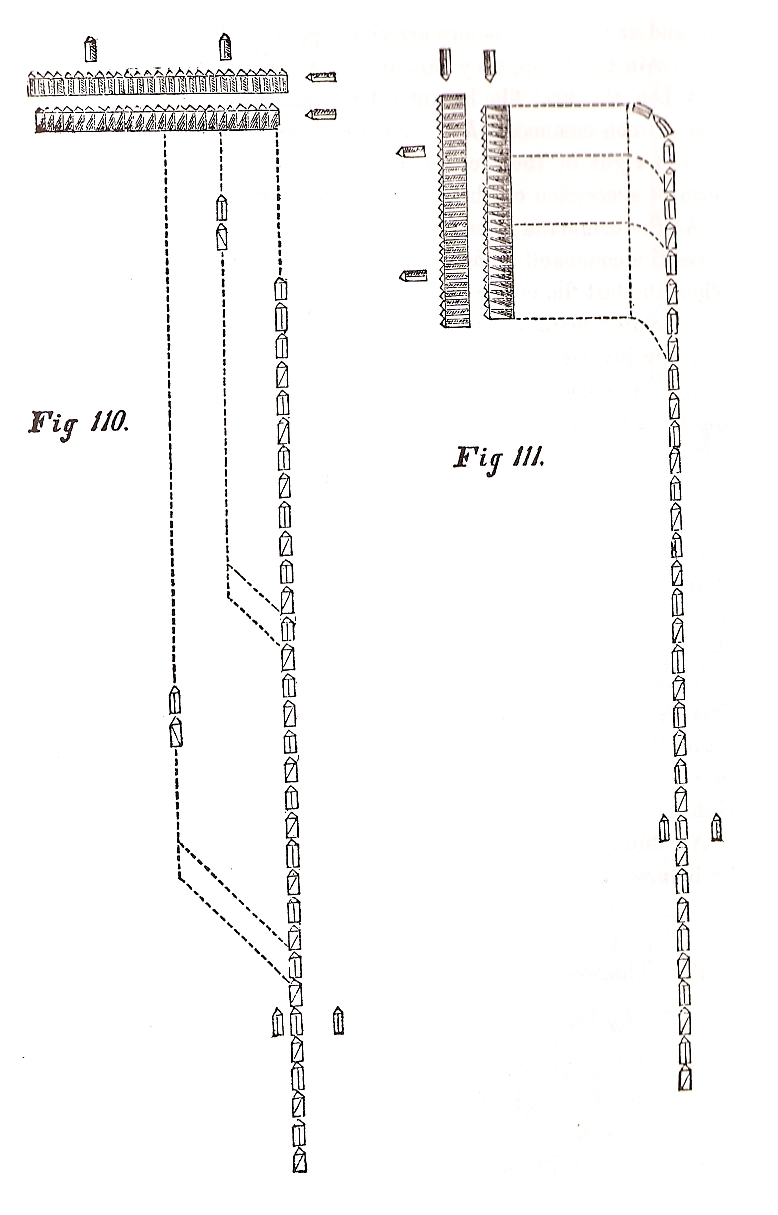
392 MANUAL FOR VOLUNTEERS AND MILITIA.
on, and at two paces before arriving opposite the place they are to occupy in the troop, they turn in succession to the left.
When the first file has marched twenty paces, the chief of the first
platoon commands halt. At this command it halts - the guide on the
right of the front rank man; the other files come up and form in
succession on the left of the first, and dress to the right.
At the command front, turn the head to the front. The captain gives the
command right-dress, immediately after halt, and front when the last
file is aligned.
A column marching left in front is formed into line on the right flank by inverse means.
484. The column marching right in front, to form in line upon the
prolongation and in advance of its right flank, the captain commands:
1. On right into line. 2. MARCH 3. Right-DRESS. 4. FRONT.
(Fig. 112.) At the command march, the first file turns to the right and
moves straight forward; the other files continue to march on, and each
turns in succession to the right, at one pace beyond the point where
the one preceding turned.
When the first file has marched twenty paces, the chief of the first
platoon commands halt. At this command it halts; the guide taking his
place on the right of the front rank, the other files come up and form
in succession on the left of the first, and dress to the right.
A column marching left in front, is formed into line on the left by inverse means.
To break the troop by twos or by fours.
485. The troop being in line, the captain commands:
1. By twos (or by fours). 2. MARCH. 3. Guide left.
(Fig. 113.) At the first command, the chief of the first platoon places
himself in front of the two or four files of the right; the right guide
places himself on his right. At the command march, the first two or
four files of the right move straight to the front; they
SCHOOL OF THE TROOP. 393
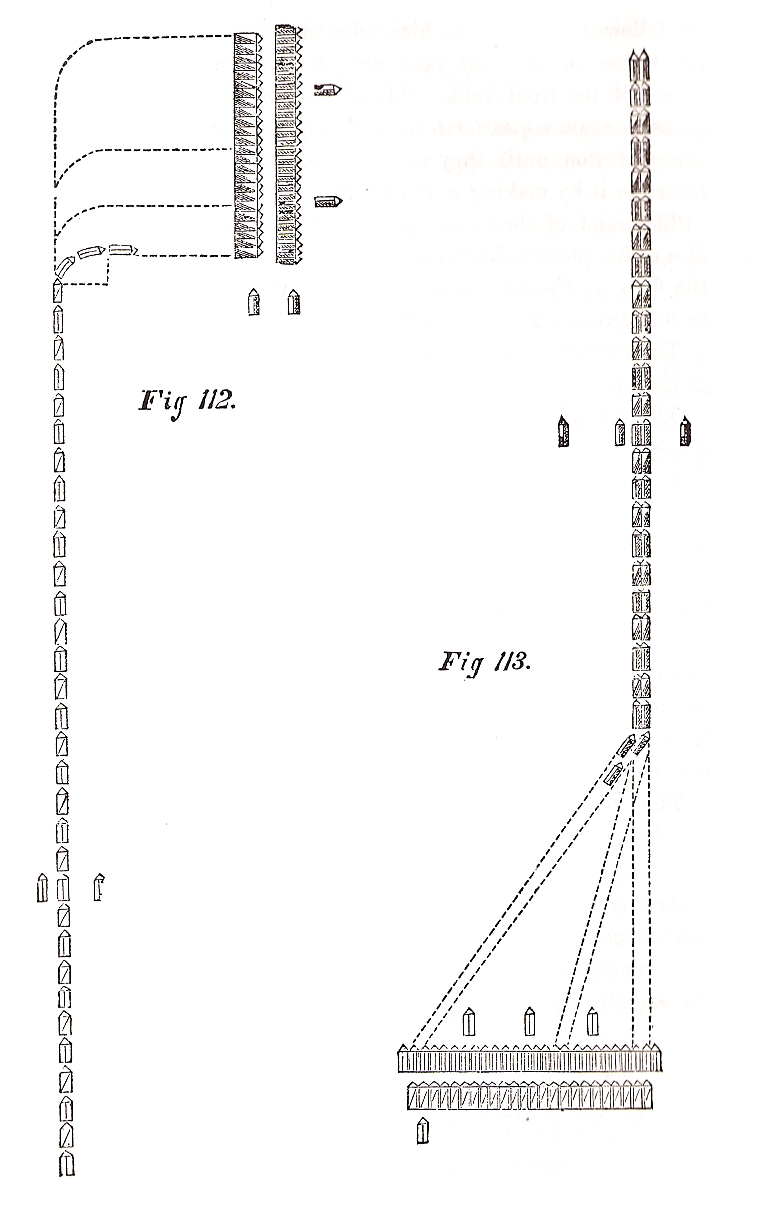
394 MANUAL FOR VOLUNTEERS AND MILITIA.
are followed by the other files, who move off when the haunches of the
horses of the rear rank are on a line with the heads of the horses of
the front rank. These files march straight forward six paces, execute a
quarter turn to the right by troopers, and march in this direction
until they meet the column, when they take their places in it by making
a quarter turn to the left.
The chief of the second platoon breaks with the first two or four files
of his platoon, keeping abreast with tpem and at one pace from the
flank of the column on the side of the guide, each rank of two or four
preserving between them the distance of two feet.
The captain assures himself that the officers, the file-closers, and guide, are properly placed.
The trooper on the left of the first rank of twos (or fours) is guide
of the column; he keeps his eyes to the front, moves straight forward,
and marches so that the troopers of his rank may be at one pace from
the croup of the horse of the chief of the first platoon. The t.rooper
on the left of each of the other ranks, who is guide of his rank,
preserves the head direct, and keeps at the distance of two feet from
his file-leader, and in the same direction; the other troopers of each
rank look occasionally towards the guide, in order to align themselves
and regulate their march upon him. They feel the boot lightly towards
that side, and yield to all pressure coming from it. When the march is
by fours, they resist all pressure coming from the side opposite the
guide.
The column marching by twos or by fours, the captain commands:
1. Trot. 2. MARCH
At the command march, the troopers take the trot, taking care not to fret their horses.
When the column has marched a sufficient distance at the trot, the captain commands:
1. Walk. 2. MARCH
486. The column marching in column of twos or fours,
right In front, to change direction, the captain commands:
Head of the column to the left (or right).
SCHOOL OF THE TROOP. 395
At this command, the chief of thc first platoon commands:
1. Left-TURN. 2. FORWARD.
At the command left, the left trooper, who is pivot, prepares to turn
at the same gait, the trooper of the opposite side to lengthen his.
At the command turn, the first rank of twos or fours turns to the left.
The pivot turns without changing his gait, describing an arc of a
circle of five paces. The trooper on the opposite side turns in
lengthening the gait; the other troopers turn the head towards the
marching flank, to regulate their rate of march, feeling lightly the
boot on the side of the pivot. At the command forward, the troopers who
had increased the gait, resume the precise pace at which they were
before moving, and the head of the column marches straight forward in
the new direction. Each rank executes the same movement, on arriving
upon the ground where the first has turned.
The column marching by twos or by fours, the captain halts it, as prescribed, school of the trooper.
To recommence the march, he commands:
1. Column forward. 2. MARCH 3. Guide left.
487. The column marching by twos or by fours, the captain commands:
1. Left (or right) oblique. 2. MARCH.
(Fig. 114.) At the command march, each trooper executes a quarter turn
to the left. The trooper on the left of the first rank, who is guide of
the column, moves straight forward in the new direction, and parallel
to the chief of the first platoon. The trooper on the left of each of
the other ranks, who is guide of his rank, moves forward also in the
new direction, observing the guide of the column so as to keep on the
same line, and in a parallel direction with him.
The other troopers move forward, looking occasionally to the left so as
to align themselves upon their guide. Each one places the
396 MANUAL FOR VOLUNTEERS AND MILITIA.
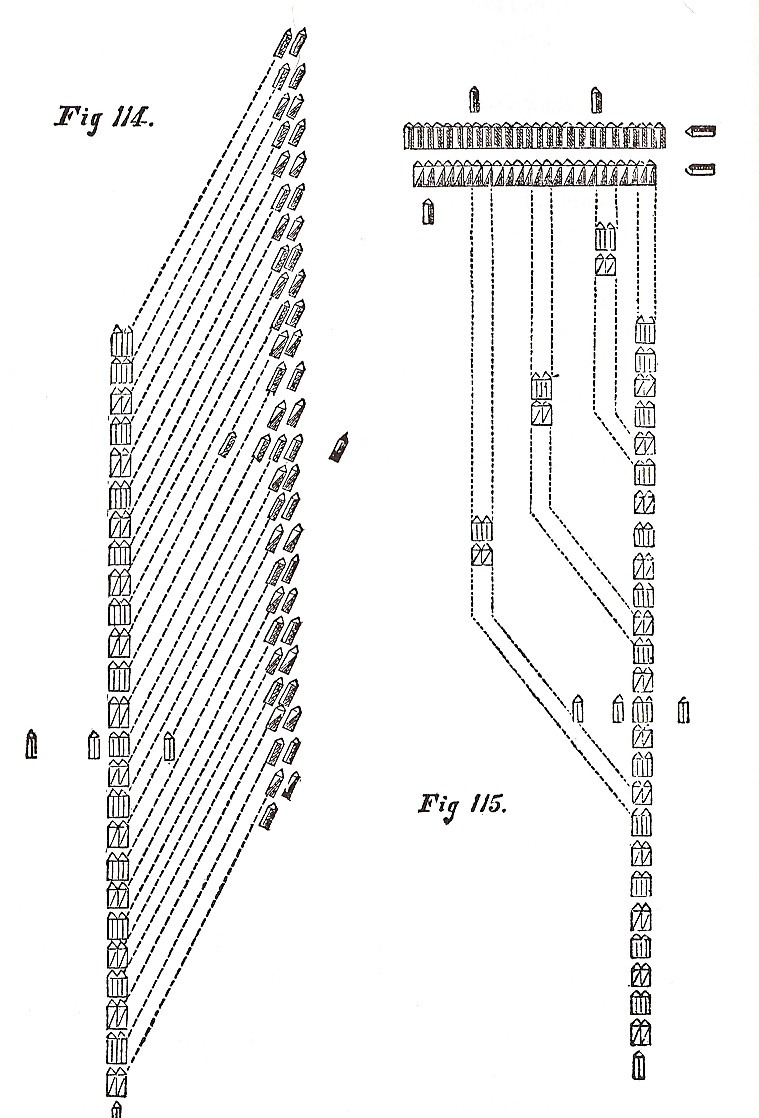
SCHOOL OF THE TROOP. 397
left knee behind the right knee of the man on the left, and the head of
his horse opposite the lower part of the neek of the horse on his left.
To return to the primitive direction, the captain commands:
FORWARD.
At this command, the troopers return to the original direction, by a quarter tum to the right.
The troop marching in column by twos or by fours, to form it to the front, to the left, or on right, into line.
488. The troop marching in column by twos or by fours, right in front, the captain commands:
1. Front into line. 2. MARCH. 3. Right - DRESS. 4. FRONT.
(Fig. 115.) At the command march, the first two (or four) files
oontinue to march straight forward: when they have marched thirty
paces, the chief of the first platoon commands:
HALT.
At this command, the first two (or four) files halt square to the
front, the guide of the right returns to the right of the troop. All
the other files of twos or fours oblique to the left, march in this
direction, and come up in succession by a quarter turn to the right on
coming opposite their places, and without command of the chiefs of
platoon.
The captain, who moves to the right flank after the command march,
commands the alignment when the chief of the first platoon commands
halt.
As soon as the chiefs of platoon arrive npon the line, they place
themselves at the centre of their platoons and align themselycs.
The guide of the left returns to the left of the troop, when the last
two (or four) files arrive upon the line. The first lieutenant
superintends the alignment of the rear rank, and then takes his post in
rear of the centre.
398 MANUAL FOR VOLUNTEERS AND MILITIA.
489 The column marching right in front, to form it in line on its left flank, the captain commands:
1. Left into line. 2. MARCH. 3. Right - DRESS. 4. FRONT.
(Fig. 116.) At the command march, the four leading files tum to the
left and move straight forward; when they have marched thirty paces,
the chief of the first platoon commands:
HALT.
At this command, the two (or four) leading files halt, and the guide
places himself on the right of the troop. All the other files cuntinue
to march on, and at three paces before arriving opposite the place they
are to occupy in the troop, turn in succession to the left, without the
command of the chiefs of platoon.
The captains, the first lieutenant, the chiefs of platoon, and the
guide of the left, conform exactly to what is prescribed for the front
into line.
490. The column marching right in front, to form line upon the
prolongation and in advance of its right flank, the captain commands:
1. On the right into line. 2. MARCH. 3. Right-DRESS. 4. FRONT.
(Fig. 117.) At the command march, the four leading files turn to the
right, and march straight forward; when they have marched thirty paces,
the chief of the first platoon commands halt.
At this command, the four leading files halt, and the right guide takes
his place on the right of the troop. All the other files continue to
march forward, each turning to the right in succession, and without the
commands of the chiefs of platoon, at the distance three paces beyond
the point where the preceding rank has turned, forming to the left, and
upon the alignment of the first.
The captain, the first lieutenant, the chiefs of platoon, and the left
guide, conform exactly to what is prescribed for the front into line.
491. The troop is broken by the left, at the commands:
SCHOOL OF THE TROOP. 397
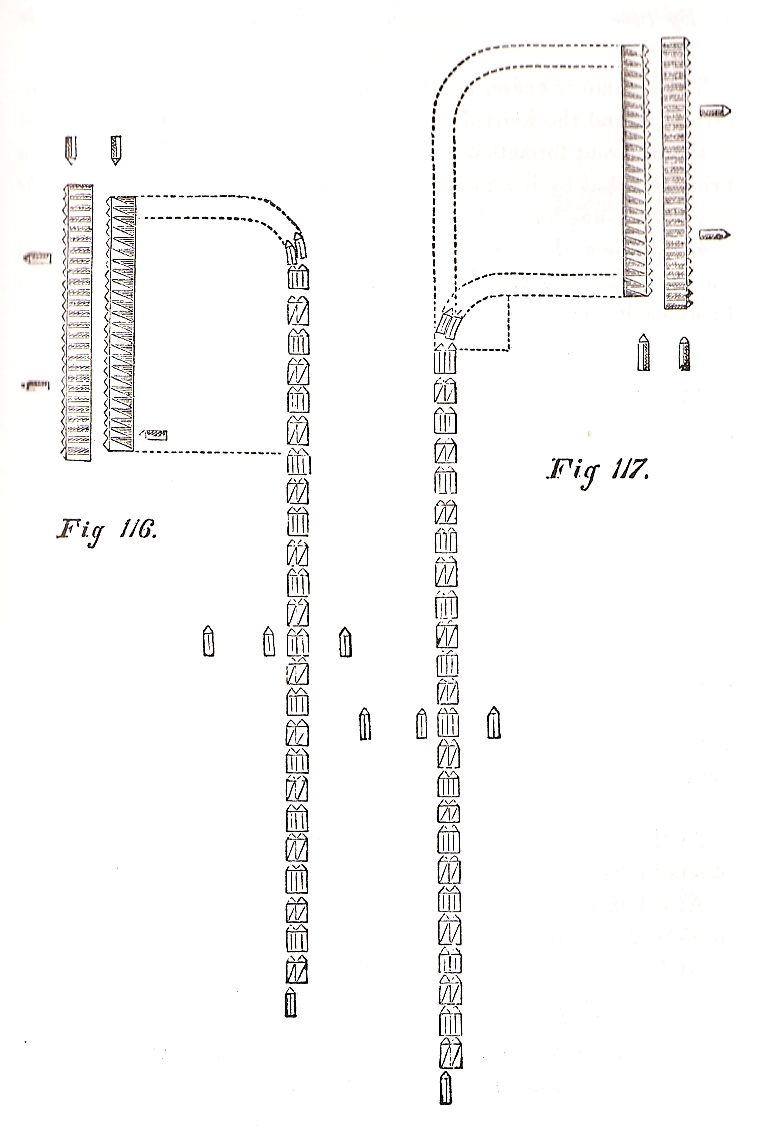
400 MANUAL FOR VOLUNTEERS AND MILITIA.
1. By twos (or by fours) from the left. 2. MARCH 3. Guide right.
The column is exercised at the march in column, the changes of
direction, and the individual oblique marches. It is also exercised at
the different formations, which are executed, following the same
principles, but by inverse means, at the commands: 1. Front (right or
on left into line. 2. MARCH. 3. Left-DRESS. 4. FRONT.
492. When the troop has acquired precision and regularity in the
formations at the different gaits, the captain exercises it in breaking
by fours from a halt at the trot, and at the gallop.
To form the troop to the left in one rank.
493. The troop being formed in two ranks, the captain commands:
1. Left into single rank. 2. MARCH 3. FRONT. 4. HALT. 5. Right - DRESS. 6. FRONT.
(Fig. 118.) At the command march, the front rank moves forward six
paces, dressing by the right; the trooper on the left of the rear rank
turns to the left and moves forward; he is followed by all the other
troopers of that rank, who execute the same movement in succession.
At the command front, the troopers of the left of the rear rank turn to
the right, and the other troopers in succession, when they have arrived
nearly opposite the place they are to occupy in the rank.
At the command halt, the trooper on the left halts, and so do the others in succession, on arriving abreast of him.
At the command right-dress, all the troopers of the rear rank dress to the right.
At the command front, turn the head to the front.
To form the troop to the right in two ranks.
494. The troop being in one rank, the captain designates the trooper
who is to be on the left of the front rank, also the one to be the
right of the rear rank, and commands:
1. Right into two ranks. 2. MARCH 3. Right-DRESS. 4. FRONT.
SCHOOL OF THE TROOP. 401
(Upper part of Fig. 118.) At the command march, the front rank moves
forward six paces, dressing by the right; the trooper on the right of
the rear rank turns to the right as soon as the front
rank has passed, and moves forward obliquely to the right; when he is
nearly in rear of the trooper on the right of the front rank, he fronts
by turning to the left. All the other troopers execute the same
movement in succession, placing themselves exactly behind their
file-leaders and at their proper distances.
At the command right-dress, all the troopers align themselves to the right.
At the command front, turn the head to the front.
To form twos and fours at the same gait.
402 MANUAL FOR VOLUNTEERS AND MILITIA.
495. The troop marching in column by file, right in front, to form twos the captain commands:
1. Form twos. 2. MARCH,
(Fig. 119.) At the command march, the first file continues to march on,
and halts when it has marched ten paces; the second file
obliques to the left; and comes up abreast of the first; on arriving
there, it halts and dresses to the right. All the other files continue
to march straight forward, Nos. 2 and 4 executing their movement in the
same manner, but in succession, and when Nos. 1 and 3, upon
SCHOOL OF THE TROOP. 403
which they should form, have nearly arrived at their proper distance, and are about to halt.
496. The troop marching in column by twos, right in front, to form fours the captain commands:
1. Form fours. 2. MARCH.
At the command march, the first two files continue to march on, and
halt when they have gone ten paces: the two following files oblique to
the left, and come up abreast of the first two; on arriving there, they
halt, and dress to the right. All the other files continue to march
straight forward, Nos. 2 and 4 of each rank executing their movement in
the same manner, when Nos. 1 and 2, upon which they should form, have
nearly arrived at their proper distance, and are about to halt.
497. When the column is at a trot, the leading file or files pass to
the walk, at the command march, the others continue to march at the
trot, until they have arrived abreast of those on which they should
form: then they pass to the walk.
When the column is at a gallop, the leading file or files pass to the
trot at the command march; the others continue at the gallop, until
they have executed their formation, when they pass to the trot.
When twos or fours are formed at the trot, or at the gallop, the guide
is announced as soon as the first files have doubled. In executing the
same movements at a walk, as the head of column halts, the guide is
not announced.
In a column marching left in front, these movements are executed by inverse means.
To break by twos and by file at the same gait.
495. The troop marching in column by fours, right in front, to break by twos the captain commands:
1. By twos. 2. MARCH. 3. Guide left.
(Fig. 120.) At the command by twos, all the troopers prepare to halt,
except Nos. 1 and 2 of the leading files. At the command march, Nos. 1
and 2 of the leading files continue to march at the
404 MANUAL FOR VOLUNTEERS AND MILITIA.
same gait; all the others halt. Files Nos. 3 and 4 of the leading rank
oblique to the right at the moment they are passed by the
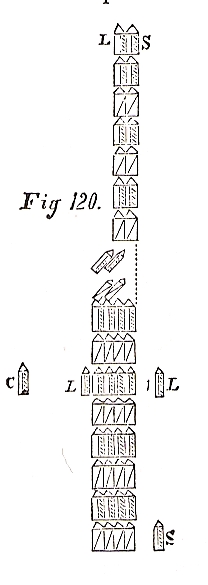
croup of the horses of the rear rank of Nos. 1 and 2, and
place themselves in column behind them.
Each rank of four executes tIle same movement in regular succession,
files Nos. 1 and 2 breaking as soon as files Nos. 3 and 4 of the rank
which precedes them have commenced obliquing, in order to enter the
column.
Files Nos. 1 and 2, which break to the front, regulate their gait so as
to preserve their distances; and files Nos. 3 and 4 keep their horses
straight, so as not to constrain the movements of files Nos. 1 and 2.
499. The troop marching in column by twos, right in front, to break by file, the captain commands:
1. By file. 2. MARCH.
At the command by file, all the troopers prepare to halt except the
right file of the leading rank of twos. At the command march, the right
file of the leading rank of twos continues to march at the same gait;
all the others halt. The left file of this same rank obliques to the
right the moment it is passed by the croup of the rear rank horse of
No.1, and places himself in column behind the first file. The guide of
the right, takes his place in rear of the chief of the first platoon.
Each rank of twos executes the same movement in succession, files Nos.
1 and 2, breaking as soon as files Nos. 2 and 4, who precede them, have
commenced obliquing in order to enter the column.
Files 1 and 3, which break to the front, regulate their gait so as to
have their distances. Files 2 and 4, keep their horses strait, so as
not to constrain the movements of files 1 and 3.
When the column is at a trot, the right files of the leading rauk
continue at that gait, all the others take the walk at the com-
SCHOOL OF THE TROOP. 105
mand march, and resume the trot on entering the column. When the column
is at the gallop, thc files which are to break take the trot at the
command march, and resume the gallop on entering the column.
The column marching left in front, the movemcnt is executed by inverse
means at the command: 1. By twos (or by file) frum the left, march. If
the column marches by twos, the guide is indicated to the right,
immediately after the command march.
To form twos and fours in doubling the gait.
500. The troop marching by file right in front, to form twos, the captain commands:
1. Form twos - trot. 2. MARCH. 3. Guide left.
At the command form twos-trot, all the troopers prepare to trot, except
the leading file, and take it at the command march. The second file
obliques to the left, and comes up abreast of the first, and on
arriving there takes the walk; all the other files continue to move at
the trot. Files 4 and 2 execute the movement in the same manner, when 3
and 1, upon whom they are to form, have nearly arrived at their
distance, and are about to pass to the walk.
501. The troop marching in column of twos, right in front, to form fours, the captain commands:
1. Form fours-trot. 2. MARCH. 3. Guide left.
At the command form fours-trot, all the troopers, except the two
leading files, prepare to take the trot, and take it at the command
march. The two files following the first two, oblique to the left, and
come up abreast of these two, resuming the walk as they do so; all the
other files continue to march forward at the trot. Files 1 and 2 of the
next file of fours close up upon the leading file, and pass to the
walk, when Nos. 2 and 4 of the same file oblique to the left, and come
up abreast of them, taking the walk; and so do all the remaining files
in succession.
When the column is at the trot, the movement is executed on the same principles. At the command march, all the troopcrs, except
406 MANUAL FOR VOLUNTEERS AND MILITIA.
the files at the head of the column, pass to the gallop, and resume the trot when the formation is executed.
The column marching left in front, the movement is executed by inverse means.
To break by twos and by file in doubling the gait.
502. The troop marching in column by fours, the captain commands:
1. By twos - trot. 2. MARCH. 3. GUIDE LEFT.
At the command by twos-trot, files 1 and 2 of the leading rank of
fours prepare to trot. At the command march, they commence the trot;
all the other files continue to march at the walk; files 3 and 4 take
the trot in succession and oblique to the right, in order to place
themselves in column behind files 1 and 2.
The movement being terminated the captain orders the walk.
503. The troop marching in column of twos, right in front, to break by file the captain commands:
1. By file - trot. 2. MARCH.
At the command by file-trot, the right file of the leading rank of twos
prepares to trot. At the command march, it commences the trot, all the
other files continue at the walk; files 2 and 4 assume the trot in
succession and oblique to the right, in order to place themselves
behind files 1 and 3 in the column.
When the column is at the trot, to break in doubling the gait, the captain commands: 1. By twos (or by file)-gallop. 2. MARCH.
504. The column marching left in front, the movement is executed by
inverse means, at the commands: 1. By twos (or by file) from the left.
2. MARCH. If the column is to march by twos, the guide is indicated to
the right, immediately after the command march.
SABRE EXERCISE.
505. The captain causes the sabre exercise to be
executed at a halt; for this purpose he opens the ranks, and commands:
SCHOOL OF THE TROOP. 407
1. By the left (or right) open files. 2. MARCH. 3. Right (or left) - DRESS. 4. FRONT.
At the command march, the right trooper of each rank moves forward six
paces; the one on the left of each rank turns to the left, and moves
forward; he is followed by all the other troopcrs of his rank, who
execute the same movement as soon as they have the necessary space to
put themselves in file at their proper distances. The second trooper
from the right of each rank, after having marched three paces, turns
and dresses to the right; each of the other troopers look occasionally
to the rear, and perform the same movement in succession when at three
paces from the one who follows him, and dresses upon those already
formed; the troopers of the rear rank place themselves exactly behind
their file-leaders.
After the command march, the captain moves to the right of the front
rank, and when the second trooper from the right has turned to the
hont, he commands, right-dress. After having rectified the alignment
and the distances in the two ranks, he commands, front.
506. When the captain wishes to re-form the troop, he commands:
1. To the right (or left) - close files. 2. MARCIH
At the command march, the right trooper of each rank moves forward six
paces; all the other troopers execute a turn to the right, and move
forward.
Each trooper, on arriving within two paces of the place he is to occupy
in line, turns to the left, and places himself on the left of the
troopers already formed, and dresses to the right. The captain closes
the ranks as soon as they are formed.
Direct march of the troop in line.
507. The most important point in the direct march being to keep the
horses straight in the ranks, it is indispensable that the trooper
should preserve the head direct.
To keep themselves aligned, the troopers should feel lightly the boot
of the man on the side of the guide, and march at an equal
408 MANUAL FOR VOLUNTEERS AND MILITIA.
gait. They should yield to all pressure coming from the side of the guide, and resist that coming from the opposite side.
The guide should always march at a free and steady gait, and change it
with steadiness in order to avoid irregularity in the ranks. If the
troopers are in front or in rear of the alignment, too near or too far
from the man on the side of the guide, they move from or approach him
gradually. When the guide feels himself thrown out of his direction, he
extends his arm to the front to indicate that there is too much
pressure towards him. When the troopers carry the hand towards the
opposite side, give a glance to the guide, and straighten their horses
as soon as the guide is relieved.
The guide should be alternately to the right and to the left, that the
troopers may acquire the habit of dressing equally well towards either
direction.
508. To march the troop forward, the captain commands:
1. Troop forward. 2. Guide right (or left). 3. MARCH.
At the command march, all the troopers move straight forward, at the same gait with the men on the side of the guide.
The troopers march straight forward, feeling the boot lightly on the side towards the guide.
To halt the troop, the captain commands:
1. Troop. 2. HALT. 3. Right (or left) - DRESS. 4. FRONT.
At the command halt, the troopers stop.
At the command right-dress, they align themselves, and at the command front, turn the head to the front.
After. the troop has been exercised sufficiently in the direct march,
at the walk, it will be practised at the trot, and afterwards at the
gallop; when marching at a gallop, the troop should habitualy pass to
the trot, and the walk, before being halted; but when the troopers are
masters of their horses, it may be halted from the gallop.
Countermarch.
509. The troop having arrived at the extremity of the ground, in order to change the direction, the captain commands:
SCHOOL OF THE TROOP. 409
1. Counter march - by the right flank 2, By file to the right. 3. MARCH.
(Fig. 12l.) At the command countermarch by the right flank, the chiefs
of platoon turn to the right, the
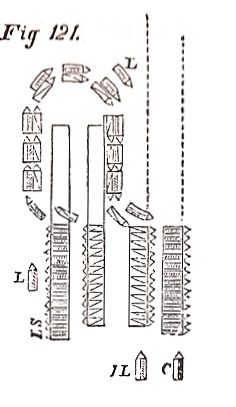
chief of the
first platoon placing himself in front of his first file; the
file-closers turn to the left, and pass to the left of the troop,
placing themselves abreast of the rear rank.
The guide of the right places himself promptly behind the guide of the
left, facing to the rear, the croup of his horse at six paces from the
rear rank.
At the command march, the trooper on the right of each rank turns to
the right, the rear rank man joining the front rank man; they then
wheel together to the right, the latter lengthening his gait a little;
they pass very near the croup of the horses of the rear rank, and are
followed by the other troopers, who execute the same movement in
succession, taking care to pass over the same ground.
When the first file is two paces from the right
guide, who indicates the place where it is to form, the captain
commands:
1. FRONT. 2. HALT. 3. Right-DRESS. 4. FRONT.
The file-closers follow the movement, and resume their places as they arrive at them.
After having commanded march, the captain moves rapidly to the flank by
which the movement is executed, in order to direct the head of the
column, and to re-form the troop to the rear upon a line parallel to
the one it at first occupied.
The troop being aligned, the captain commands, front. At this command,
the chiefs of platoon face to the front, by a turn to the left.
The countermarch should generally be executed at the trot. For this
purpose, after the second command, the captain indicates the gait.
This movement is executed by the left flank by inverse means.
410 MANUAL FOR VOLUNTEERS AND MILITIA.
The troop being in line, to form it in column with distance.
510. The captain commands:
1. Platoons right wheel. 2. MARCH. 3. HALT.
(Fig. 122.) At the first command, the left file of each platoon
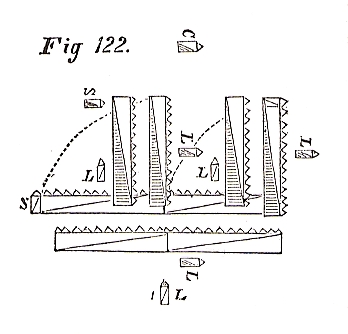
prepares to step off promptly, and the pivot to turn upon
its own ground.
At the command march, each platoon executes its wheel to the right,
following the principles of the wheel on a fixed pivot, the marching
flanks taking care to step off and wheel together.
At the command halt, the marching flanks and all the troopers halt at
the same instant, those of the rear rank resuming their places behind
their file-leaders.
The captain commands halt, when the platoons have nearly completed the wheels.
The chiefs of platoon, without leaving their platoons, observe that the movement is correctly executed.
During the movement, the guide of the left passes as
file-closer behind the second file from the left of the second platoon.
To march in column with distance.
511. In this order of column, the guides should preserve betwecn them a
distance equal to the front of their platoons, and regulate their gait
upon that of the preceding guide.
The chiefs of platoon are responsible for the preservation of the
distance, which should be half of the front of the platoon, assuming it
to contain twelve files, measured from the croup of the horses of the
rear rank of the leading platoon, to the head of the horses of the
front rank of the rear platoon.
The troop being in open column, right in front, the captain commands:
SCHOOL OF THE TROOP. 411
1. Column forward. 2. MARCH. 3. Guide left.
At the command march, both platoons put themselves in motion at the same time.
Before the column commences the march, the captain
gives the guide of the first platoon a point of direction.
Changes of direction.
512. In the open column, the changes of direction are executed by
successive wheels on a movable pivot, so that the march of the column
may not be retarded. The arc of the circle described by the pivots
should be five paces.
The column being in march, to change the direction, the captain commands:
Head of column to the left or half-left (or to the right or half-right).
(Fig. 123.) At this command, the chief 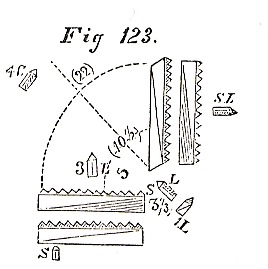
of the first platoon commands: 1. Left-TURN; 2. FORWARD; which is executed on the principle of the wheel upon a movable pivot.
The chief of the second platoon gives the same commands in time for his platoon to turn upon the same ground.
In this change of direction while marching, the guide of the right at
the command head of column to the left, moves rapidly to the side of
the pivot, and places himself so that the head of his horse will mark
the centre point of the arc described by the pivot.
Both platoons commence their wheel at two and a half paces before
arriving abreast of the head of the horse of the guide of the right, so
as to prevent the column frolll being thrown out. The guide resumes his
place when the second platoon has completed its wheel.
Individual oblique march.
513. The troop marching in column, with distance, right in front,
412 MANUAL FOR VOLUNTEERS AND MILITIA.
to cause it to gain ground towards one of the flanks, without changing the front of the columns, the captain commands:
1. Left (or right) oblique. 2. MARCH
(Fig. 124.) At the command march, the troopers all execute, at the same
time, a quarter turn to the right, so that the
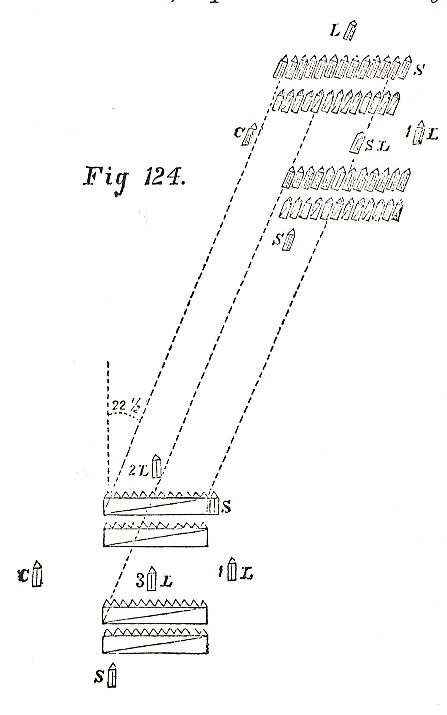
head of each horse may be opposite the extremity of the neck of the
horse on his nght, and that the right knee of each trooper may be in
rear of the left knee of the trooper on his right. This first movement
being executed, the troopers move forward in the new direction,
regulating themselves upon the guide.
The guide of the second platoon pays attention to march on the
same line, to preserve his distance, and to keep in a dlrection
exactly parallel to that of the guide of the first platoon.
To resume the primitive direction, the captain commands:
FORWARD.
At this command the troopers straiten their horses, and move forward, regulating themselves upon the guide.
In the oblique march, the guide is always on the obliquing side,
without being indicated; and after the command forward, the guide
returns, without indication, to the side on which it was before the oblique.
SCHOOL OF THE TROOP. 413
To break by fours, by twos, and by file; to form twos, fours and platoons at the same gait.
514. The troop marching in column with distance,
right in front, to break by fours at the same gait, the captain
commands:
1. By fours. 2. MARCH. 3. Guide left.
At the command by fours, repeated by the chief of the first platoon,
this officer places himself in front of the first four files on the
right; the right guide places himself on his right.
At the command march, which is also repeated by the chief of the
platoon, this platoon breaks by fours as prescribed No. 485, and the
chief of the second platoon commands halt.
The chief of the second platoon commands by fours, in sufficient time
to command march, the moment the last four files of the first platoon
commence the oblique movement. in order to enter the column.
515. The troop marching in column by fours, right in
front, to break by twos, at the same gait, the captain commands:
1. By twos. 2. MARCH. 3. Guide left.
The chiefs of platoon conform to what is prescribed in order to break
by fours, and give the commands, halt; and then, 1. By twos. 2. MARCH;
so as to cause no confusion in the column.
516. The troop marching in column by twos, right in
front, to break by file at the same gait, the captain commands:
1. By file. 2. MARCH.
Which is executed as prescribed for breaking by twos, the guide of the
right placing himself behind the chief of the first platoon.
517. The troop, marching in column with distance, at the trot, right in
front, to break by fours, at the same gait, the captain commands.
1. By fours. 2. MARCH. 3. Guide left.
At the first command, repeated by the chief of the first platoon,
414 MANUAL FOR VOLUNTEERS AND MILITIA.
this officer and the guide of the right, place themselves as prescribed
No. 514, and the chief of the second platoon commands, walk.
At the command march, repeated by both the chiefs of platoon, the first
platoon breaks by fours, as prescribed No. 514, and the second platoon
takes the walk.
The chief of the second platoon commands, by fours-trot, in sufficient
time to command march, when the last four files of the first platoon
commence the oblique movement in order to enter the column.
The same principles are applicable to breaking by twos, and by file.
When the column is at the gallop, these movements are executed on the
principles just prescribed, the whole column except the first four
files, passing to the trot, and resuming the gallop, as the files break
in order to enter the column.
518. The troop marching in column by file, right in
front, to form twos at the same gait, the captain commands:
1. Form twos. 2. MARCH.
At the commands form twos, and march, repeated by the chief of the
first platoon, this platoon executes the movement as prescribed No.
500; the guide of the right moves to the right of the chief of the
first platoon, who commands, halt, after having marched ten paces. The
other platoon continues to march by file, and executes the movement at
the command of its chief, who does not command march until the first
files of his platoon has arrived at its proper distance.
519. The troop marching in column by twos, right in
front, to form fours, at the same gait, the captain commands:
1. Form fours. 2. MARCH.
Which is executed as is prescribed for forming twos.
520. The troop marching in column of fours, right in
front, to form platoons at the same gait, the captain commands:
1. Form platoons. 2. MARCH.
SCHOOL OF THE TROOP. 415
At the first command, the chief of the first platoon commands, form platoon.
At the command march, repeated by thc chief of the first platoon, the
guide of the right places himself on the right of this platoon, which
forms as in front into line, No. 488; the chief of the platoon commands
halt, after having marched twenty paces.
The other platoon continues to march in column by fours, and forulR at
the command: 1. Form platoon MARCH; given by its chief in sufficient
time to command halt, when the first four files of the platoon arrives
at six paces from the platoon which precedes.
521. When the column is at the trot, the same principles are conformed
to, except that instead of halting, the first two or four files of the
first platoon pass to the walk, at the command march given by their
chief. The second platoon continues to march at the trot, and execute
the movement at the same gait, the first two or four files of the
platoon passing also to the walle, at the command march, given by the
chief of the platoon when they arrive at their proper distances.
When the column is at the gallop, to form twos, fours, etc., the same
principles are observed, the first two or four files of each platoon
passing to the trot at the command march, given by their chief.
When these formations are executed at the trot, and at the gallop, the
guide is announced by the captain as soon as the first files have
doubled, or the first platoon is formed; in the last case only, each
chief of platoon repeats the command of the guide as soon as his
platoon is formed.
To break by fours, by twos, and by file; to form twos, fours and platoons, in doubling the gait.
522. The trooper marching in column with distance, right in front, to
break by fours, in doubling the gait, the captain commands:
1.By fours-trot. 2. MARCH. 3. Guide left.
At the first command, repeated by the chief of the first platoon,
416 MANUAL FOR VOLUNTEERS AND MILITIA.
this officer, and the guide of the right, place themselves as prescribed, No. 514.
At the command march, repeated by thc chief of the first platoon, this platoon breaks by fours, as prescribed, No. 514.
The other platoon continues to march at the walk; its chief commands,
by fours-trot, in sufficient time to command march, the moment the last
four files of the first platoon commence the oblique movement in order
to enter the column.
These principles are applicable to breaking by twos and by file. When
the column is at the trot, to break at the gallop, the same principles
are observed at the commands:
1. By fours-gallop. 2. MARCH. 3. Guide left.
523. The troop marching in column by files, to form twos in doubling the gait, the captain commands:
1. Form twos - trot, 2. MARCH, 3. Guide left,
At the commands form twos - trot, and march, repeated by the chief of
the first platoon, this platoon executes its movement as prescribed,
No. 500, and the guide of the right moves to the right of the chief of
the first platoon.
At the first command, the chief of the second platoon commands, trot,
At the command march, repeated by him, the second platoon takes the
trot. He commands, form twos, in sufficient time to command march, the
moment the first file of the platoon is nearly at its proper distance;
the first file then passes to the walk.
524. The troop marching in column of twos, to form fours, in doubling the gait, the captain commands:
1. Form fours-trot. 2. MARCH. 3. Guide left.
Which is executed as prescribed for forming twos.
525. The troop marching in column by fours, to form platoon, in doubling the gait, the captain commands:
1. Form platoons-trot. 2. MARCH. 3. Guide left.
SCHOOL OF THE TROOP. 417
At the first command, the chief of the first platoon commands, form platoon - trot.
The chief of the second platoon commands trot.
At the command march, repeated by these officers, the first platoon
forms as prescribed, No. 520, and the guide of theright places himself
on the right of this platoon, The second platoon takes the trot. The
chief of this platoon gives the command, form twos, in sufficient time
to command march, the moment the first file of his platoon is nearly at
its proper distance; the first file then passes to the walk.
526. The troop marching in column by twos to form fours, in doubling the gait, the captain commands:
1. Form fours - trot. 2. MARCH. 3. Guide left.
Which is executed as prescribed for forming twos.
527. The troop marching in column by fours, to form platoons, in doubling the gait, the captain commands:
1. Form platoons - trot. 2. MARCH 3. Guide left.
At the first command, the chief of the first platoon commands, form platoon - trot.
The chief of the second platoon commands trot. At the command march,
repeated by these officers, the first platoon forms as prescribed, No.
520, and the guide of the right places himself on the right of this
platoon.
The second platoon takes the trot, and forms at the command form
platoon, given by its chief in sufficient time to command march, when
the first four files arrive at their proper distance from the first
platoon; then these four files take the walk.
The captain commands guide left when the first platoon is formed, and gives a point of direction.
The chief of the second platoon commands the guide as soon as his platoon is formed.
When the column is at the trot, these formations are executed at the
gallop, following the same principles, at the commands: 1. Form twos,
or form fours, or form platoons - gallop. 2. MARCH
418 MANUAL FOR VOLUNTEERS AND MILITIA.
The troop marching in column with distance, to face
it in the opposite direction, and to face it to the front again.
528. The troop marching in open column, right in front, the captain commands:
1. Platoons left-about wheel. 2. MARCH.
(Fig. 125.) At the first command, the trooper on the left of
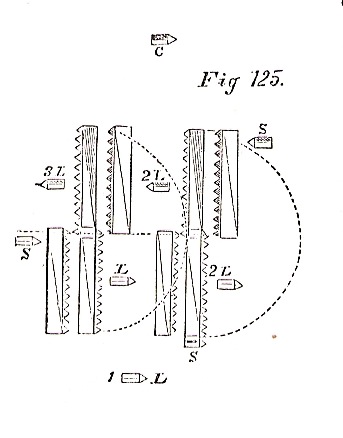
each platoon, who becomes the pivot, prepares to halt
without, however, slackening his pace.
At the command march, the pivots halt, and the marching flanks wheel at
the gait in which the column was marching, regulating themselves upon
the onter flank of the platoon at the head of the column, so as to
complete the first half of the movement at the same instant.
The movement being nearly finished, the captain commands:
1. Forward. 2, Guide Right.
During this movement, the guide of the left places himself on the left
of the second platoon; the guide of the right takes his place as
file-closer in rear of the second file from the right of the first
platoon, and the other file-closers pass to the side opposite the
guide.
To cause the troop to resume its primitive direction, the captain
commands: 1. Platoons right - about wheel. 2. MARCH. 3. FORWARD. 4.
Guide left.
529 .The column being on the march, to halt it, the captain commands:
1. Column. 2. HALT.
At the first command, both platoons prepare to halt, and at the command halt, halt at the same time.
SCHOOL OF THE TROOP. 419
To form line to the left.
530. The troop being in column with distance, right
in front, to form it in line on its left flank, the captain commands:
1. Left into line, wheel. 2. MARCH. 3. HALT. 4. Right-DRESS. 5. FRONT.
At the first command, the guide of the right moves upon the
prolongation of the guides of the column, at the distance of the front
of a platoon, facing the side towards which the line will be formed.
At the command rnarch, the troop wheels into line, the trooper on the
left wing of each platoon serving as pivot, and turning upon his own
ground.
The captain commands halt the moment the marching flanks have nearlt completed their movement, and then right dress.
At this command, both platoons align themselves. The troop being aligned, the captain commands front.
During the wheel, the guide of the left resumes his place in line.
531. The formation of the troop into a column with distance, left in
front; the march of this column; the changes of direction in a column;
left in front; etc. etc., are executed upon the same principles as a
column right in front, but by inverse means.
To forrn line to the right by inversion.
532. The troop marching in open column, right in front, to form it in
line upon its right flank by inversion, the captain changes the guide;
for this purpose, he commands:
Guide Right.
The captain passes by the head of the column to the side of the new
guides, rectifies their direction, then halts the column, and commands:
420 MANUAL FOR VOLUNTEERS AND MILITIA.
1. By inversion right into line wheel. 2. MARCH. 3. HALT. 4. Left-DRESS. 5. FRONT.
Which is executed as prescribed for wheeling into line to the left, but by inverse means.
To put the troop in column again, right in front, the captain commands:
1. Platoons left wheel. 2. MARCH. 3. HALT (or FORWARDS. 4. Guide left.
To form on right into line.
533. The troop marching in column with distance, right in front, to
form it in line on the prolongation and in advance of its right flank,
the captain commands:
1. On right into line. 2. MARCH. 3. Guide-RIGHT. 4. FRONT.
(Fig. 126.) At the first command the chief of the
first platoon commands right, and at the command march, he commands
turn:
the platoon turns to the right and moves forward at the command
forward; when it has marched thirty paces, its chief commands halt, and
then nght - dress.
SCHOOL OF THE TROOP. 421
The second platoon continues to march forward, without approaching the
line; as soon as it arrives abreast of tho fourth file from the left of
the first platoon, its chief commands: 1. Right-TURN. 2. FORWARD. The
platoon then directs itself towards the place it is to occupy in line,
and on arriving abreast of the file-closers, its chief commands halt,
and then left - dress.
When the troop is aligned, the captain commands, front.
To form on left into line by inversion.
534. The troop marching in column with distance, right in front, to
form it in line upon the prolongation and in advance of its left flank,
the captain commands:
l. By inversion on left into line. 2, MARCH. 3. Guide left. 4. FRONT.
At the first command, the chief of the first platoon commands, left.
At the command march, he commands, turn; the platoon turns to the left,
and moves forward at the command forward;when it has marched thirty
paces its chief commands halt, and then left -dress.
The second platoon continues to march forward, without approaching the
line; when it arrives abreast of the fourth file from the right of the
first platoon, its chief commands: 1. Left - TURN 2. FORWARD; this
platoon directs itself towards the place it is to occupy in line, and
on arriving abreast of the file-closers, its chief commands halt, and
then left-dress.
To form front into line.
535. The troop being in column with distance, right in front, to form
it in line upon the head of the column, the captain commands:
1. Front into line. 2. MARCH. 3. Guide Right. 4. FRONT.
(Fig. 127.) At the first command, the chief of the first platoon
commands, platoon forward, and the chief of the seyond commands platoon
left half wheel.
422 MANUAL FOR VOLUNTEERS AND MILITIA.
At the command march, repeated by these officers, the first platoon moves forward; its chief repeats the indication of the
guide, and when it has marched thirty paces, he commands: 1. HALT. 2. Right - DRESS.
The chief of the second platoon, when the left half wheel is executed,
commands: 1. FORWARD. 2. Guide right; and marches straight forward.
When the right of his platoon arrives opposite the left of the first
platoon, he commands: 1. Right half wheel. 2. FORWARD: and when he
arrives abreast of the file-closer: 1. HALT. 2. Right-DRESS.
The troop being aligned, the captain commands, front.
To form line faced to the rear, on the rear of the column.
536. The troop being in column with distance, right
in front, to form line faced to the rear, the captain commands:
1. Platoons left about wheel. 2. MARCH 3. Front into line. 4. MARCH. 5. Guide left. 6. FRONT.
(Fig. 128.) At the second command, each platoon executes its wheel to the left about.
SCHOOL OF THE TROOP. 423
At the fourth command, the chief of the second platoon, now in front,
when its wheel is nearly completed, commands forward, guide left; and
when it has marched thirty paces: 1. HALT. 2. Left-DRESS.
The chief of the second pbtoon, on completing three-fourths of his
wheel, commands: 1. FORWARD. 2; Guide left, and directs it towards the
place it is to occupy in line, conforming in other respects to what is
prescribed front into line, when the column is left in front.
To form line faced to the rear on the head of the column.
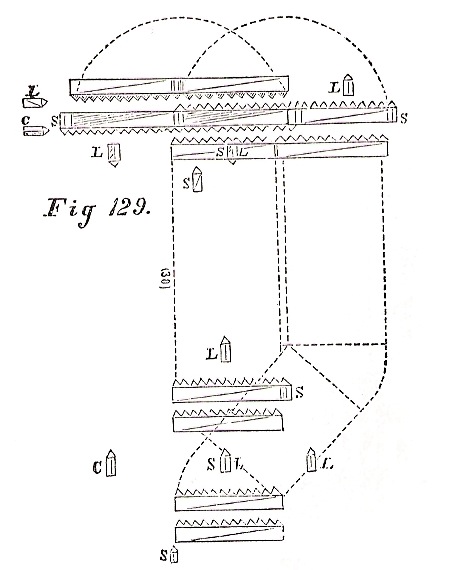
537. The troop being in column with distance, right in front, to form
line faced to the rear upon the head of the column, the captain
commands:
1. By inversion front into line. 2. MARCH 3. Guide left.
(Fig. 129). At the first command, the chief of the
first platoon commands, platoon forward; and the chief of the second,
platoon right half wheel.
At the command march, repeated by these ofllcers, the movement is
executed ns prescribed for front into line, but by inverse means.
The captain without rectifying the alignment, commands:
l. Platoon left-about wheel. 2. MARCH 3. HALT. 4. Right-DRESS. 5. FRONT.
Movements by fours, the troop being in column with distance.
538. The troop being in column with distance, right in front, to
424 MANUAL FOR VOLUNTEERS AND MILITIA.
cause it to gain ground towards its left flank, the captain commands:
1. By fours left wheel. 2. MARCH 3. FORWARD. 4. Guide right.
(Fig. 130.) At the command march, each rank of fours executes its wheel
to the left, according to the principles of the wheel on a fixed pivot;
Nos. 4 turn upon themselves, sustaining with the left
leg the haunches of their horses, in order not to constrain the
movement of the rank immediately behind them; all the troupers regulate
themseIves towards the marching flanks.
SCHOOL OF THE TROOP. 425
539. To take a direction parallel to the first, and return to columm with distance, the captain commands:
1. By fours right wheel. 2. MARCH. 3. HALT.
Which is executed on the same principles, but by invers means. If
instead of halting, the captain wishes the column to march forward, he
commands: 1. FORWARD. 2. Guide left.
540. The troop being in column with distance, right in front, it is
caused to gain ground towards its right flank by the commands: 1. By
fours right wheel. 2. MARCH. 3. FORWARD. 4. Guide left; and to resume
the primitive direction at the commands: 1. By fours left wheel. 2.
MARCH 3. HALT (or FORWARD). 4. Guide left.
541. The troop being in column with distance, right
in front, to cause it to march to the rear the captain commands:
1. By fours left about wheel. 2. MARCH 3. FORWARD. 4. Guide right.
(Fig. 131.) At the command march, the movement is executed in each rank
by fours, so as to throw the rear rank before the front rank, and the
ranks of fours are inverted throughout the column.
If, instead of moving forward after the wheel to the left about by
fours, the captain wishes to halt the column, he commands, halt.
To return to the primitive direction, the captain commands:
1. By fours right about wheel. 2. MARCH. 3. HALT.
Which is executed as just prescribed, but by inverse means.
If the captain wishes the column to march forward, he commands: 1. FORWARD. 2. Guide left.
542. In all the movements to the left and to the right by fours, the
chiefs of platoon move up abreast of the first rank of their platoons,
on the side of the guide.
The captain, the file-closers, and the guides of the right and left,
preserve their places after the wheel to the left or right by fours is
completed, facing in the new direction.
In the wheel to the left or right about by fours, the chiefs of pla-
426 MANUAL FOR VOLUNTEERS AND MILITIA.
toon march behind the centre of their platoons, and the file-closers in
front. The guidc of the right is on the left of his platoon, and the
guide of the left in front of his.
WHEELINGS.
543. During the wheel, the chiefs of platoon keep at the centre of
their platoons, and correctly aligned, keeping their horses upon the
arc of a circle, more or less great, in proportion to their distance
from the pivot. The files on the flanks of platoons close upon each
othcr, all observing the progression of the marching flank, and keeping
upon the arcs they should describe.
To wheel on a fixed pivot.
544. The troop is exercised in wheeling on a fixed pivot, first at the walk, then at the trot; also at the gallop.
The troop being halted and correctly aligned, the captain commands:
1.Troop in circle to the right. 2. MARCH.
Which is executed on the principles prescribed, Nos. 434 and 435.
To halt the troop during the wheel, the captain commands:
1. Troop. 2. HALT. 3. Left - DRESS. 4. FRONT.
At the first command, the troopers of the rear rank
straighten their horses, and resume their places behind their
file-leaders.
At the second command, all the troopers halt.
At the third command, the troop dresses to the lcft. The troop being aligned, the captain commands front.
If instead of halting, the captain wishes to resume the direct march, he commands:
1. Forward. 2. Guide left.
At the first command, the troopers of the rear rank straighten their
horses, and place themselves behind their file-leaders, and the whole
troop moves forward at the gait in which it was marching before the
wheel.
SCHOOL OF THE TROOP. 427
545. The troop wheeling to the right, at the walk, or at the trot, the captain commands:
1. Troop to circle left wheel. 2. MARCH.
Which is cxecuted as prescribed Nos. 434 and 435. 546.
The troop being halted the captain commands:
|
1. Troop. |
{ |
Right (or left wheel).
Right about (or left-about) wheel.
Right-half (or left-half) wheel. |
} |
2. MARCH |
3. Troop. 4. HALT. 5. Left (or right) - DRESS. 6. FRONT.
To exercise the troop while marching at the wheels on a fixed pivot, the captain commands:
|
1. Troop. |
{ |
Right (or left wheel).
Right about (or left-about) wheel.
Right-half (or left-half) wheel. |
} |
2. MARCH |
3. FORWARD. 4. Guide left (or guide right.)
To wheel on a movable pivot.
547. The troop marching in line, to change direction to the right, the captain commands:
1. Right-Turn. 2. FORWARD.
Which is executed as prescribed, No. 438, the pivot describing an arc of a circle of fifteen paces.
Movements by fours.
548. The troop being in line, to cause it to gain ground towards its right flank, the captain commands:
1. By fours right-wheel. 2. MARCH. 3. FORWARD. 4. Guide left
Which is executed as prescribed, No. 540. The chiefs of platoon march
on the side of the guide, at one pace from, and abreast of the leading
files of their platoon.
The guide of the right marches in front of the column, at one pace from
the leading rank of eight, the guide of the left. behind the last rank
of eight of the second platoon.
428 MANUAL FOR VOLUNTEERS AND MILITIA.
To put the troop in line again, the captain commands:
1. By fours, left wheel. 2 . MARCH. 3. HALT. 4. Right-DRESS. 5. FRONT.
Which is executed as prescribed, No. 540, the guides resuming their places in line.
Tlte troop marching in line, to break it by platoons, to the right, and to form it again into line.
540. The troop marching in line, to cause it to gain ground towards its right flank, the captain commands:
1. Platoons right wheel. 2. MARCH. 3. FORWARD. 4. Guide-Left.
Which is executed as prescribed, No. 510, the pivots halting short, and
the left file of each platoon stepping out promptly, so as to arrive
together in column.
To put the troop in line again, the captain commands:
1. Platoons left wheel. 2. MARCH. 3. FORWARD. 4. Guide - Right.
The marching flanks regulate their movements so as to arrive together in line.
The troop marching in line to break it to the front by platoons, and to re-form it.
550. The captain commands:
1. By platoon to the front. 2. MARCIL 3. Guide left.
(Fig. 132.) At the command march, the first platoon continues to march
forward; its chief repeats the command guide left. At the first
command, the chief of the second platoon commands: platoon right
half-wheel, which is commenced at the command march; when it is
executed, the chief of the plattoon commands: 1. FORWARD. 2. Guide
left; and marches it straight forward. When the left of his platoon
arrives in the direction of the first
SCHOOL OF THE TROOP. 429
platoon, he commands, 1. Left half wheel. 2. MARCH. 3. FORWARD; in order to take his position in column.
The movement is executed in the 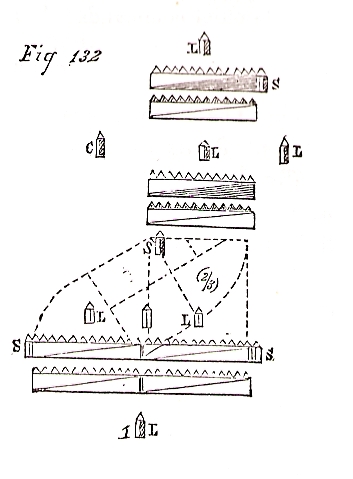 same manner at the trot, and at the the gallop.
same manner at the trot, and at the the gallop.
551. The troop marching in column with distance,
right in front, to form it at the same gait. the captain commands:
1. Form troop. 2. MARCH 3. Guide right.
Which is executed in the same manner as front into line, No. 535,
except that as the troop is on the march the chief of the first platoon
does not command platoon forward, or march, but repeats the command for
the guide.
The troop marching at the trot, this movement is executed on the same
principles, except that the chief of thc first platoon commands: 1.
Walk. 2. MARCH; the guide of the right moving up on the line with the
chiefs of platoon, and the chief of the second platoon commands; 1.
Walk. 2. MARCH; on arriving in line. When the column is at the gallop,
the platoons take the trot in succession.
The troop marching in line it is broken by the left by inverse means,
at the commands: 1. By the left - by platoons to the front. 2. MARCH 3.
Guide right.
The same movement may he performed by doubling the gait, at the
commands: 1. By platoons to the front- trot. 2. MARCH. 3. Guide left.
At the first command, the chief of the first platoon commands, trot;
the chief of the second commands, platoon right half wheel -trot.
At the command march, the movement is executed as before.
The line may be re-formed at the commands: 1. Form troop trot. 2.
MARCH. 3. Guide right. At the first command, the chief of the second
platoon commands, platoon left half-wheel- trot.
430 MANUAL FOR VOLUNTEERS AND MILITIA.
The first platoon continues to march at a wall., and its chief repeats
the command for the guide. When the second platoon arrives in line, its
chief commands; 1. Walk. 2. MARCIl.
THE CHARGE.
552. The troop is exercised at the charge; 1. In line. 2. In colnmn. 3. As foragers.
The charge in line, executed by the troop when in line; it should be as
short as possible, so as arrive in good order, and without fatiguing
the horses.
The charge in column is exercised by the troop when broken into column of platoons with distance.
To execute the charge as foragers, all the troopers of the troop
disperse, and direct themselves each upon the point he wishes to
attack, observing not to lose sight of their officers, who charge with
them.
553. The troop being in line, the captain orders the
sabres to be drawn, and the platoons to charge in succession.
For this purpose the captain advances 240 paces to the front, taking a
trumpeter with him; and when he wishes the movement to commence, he
causes a signal to be given.
The first platoon then moves forward at the commands; 1. Platoon
forward. 2. Guide right (or left). 3. MARCH; by its chief. It passes in
succession from the walk to the trot, from the trot to the gallop, and
from the gallop to the charge.
When the platoon has moved somc sixty paces at the charge, the chief of platoon commands; 1. Attention. 2. Platoon. 3. HALT.
4. Right - DRESS. 5. FRONT.
At the command attention, the troopers carry the sabre to the shoulder.
At the command platoon, they take the trot. At the command halt, they
stop. At the command right - dress, they align themselves to the right.
At the command front, turn the head to the front.
The second platoon follows when the first has halted.
554. To execute the charge by the troop, the captain
places himself in front of the centre of his troop, and commands;
SCHOOL OF THE TROOP. 43l
1. Troop forward. 2. Guide right (or left). 3. MARCH.
When the troop has marched twenty paces, he commands; 1. Trot. 2. MARCH.
At sixty paces farther, he commands;
1. Gallop. 2. MARCH.
At eighty paces further, he commands;
CHARGE.
At this command, repeated by the chiefs of platoons, the troopers of
both ranks take the position of raise - sabre. They give hand and
lengthen the gallop, without losing control of their horses or
disuniting.
When the troop has passed over sixty paces to the charge, the captain commands:
1. Attention. 2. Troop. 3. HALT. 4. Right-DRESS. 5. FRONT.
At the command attention, repeated by the chiefs of platoon, the
troopers prepare to slacken the pace, and carry the sabre to the
shoulder.
At the command troop, the chiefs of platoon command platoon, and the troopers pass to the trot.
At the command halt, repeated by the chiefs of platoon, the troopers halt.
At the command right-dress, they align themselves to the right. The troop being aligned, the captain commands front.
When the troop executes the charge correctly,
instead of halting when the charge is finished, the captain commands;
1. Attention. 2. Trot. 3. MARCH.
555. At these commands, repeated by the chiefs of platoon, the troop passes to the trot, and he commands;
1. First (or second) platoon- as foragers. 2. MARCH.
At these commands, repeated by the chief of the platooon desig-
432 MANUAL FOR VOLUNTEERS AND MILITIA.
nated, the platoon moves forward at the gallop, and disperses as foragers. A trumpeter follows the chief of the platoon.
The other platoon follows at a trot; when it has passed over 150 pacee,
the captain causes the rally to be sounded. At this signal, repeated by
the trumpeter of the platoon dispersed as foragers, the latter rally
upon the other platoon by wheeling to the left about, and resuming
their places in rank by the shortest line, the troopers cntering the
ranks by the rear. When three-fourths of the platoon have rallied and
are in line, the captain commands :
1. Attention. 2. Gallop. 3. MARCH. 4. CHARGE.
The troop again executes the charge in line; the
troopers who have not been able to rally, charge upon the flanks of the
troop.
556.The troop marching in column with distance, at the trot, the captain commands:
1. To the charge. 2. MARCH.
At the first command, the chief of the first platoon commands gallop.
At the command march, repeated by the ehief of the first platoon, this platoon commences the gallop.
The other platoon follows at a trot, taking the gallop, when the first platoon has gotten 50 paces in front of it.
When the first platoon has passed over 80 paces at the gallop, its
chief commands charge. At this command the platoon executes the charge;
and when it has passed over 60 paces, its chief causes it to pass to
the trot, by the commands: 1. Attention. 2. Trot. 3. MARCH.
The other platoon pays attention to the movements of the first, so as
to change the gait in time, and to resnme the ordillary distance; the
captain halts the column when he thinks proper. These charges are
executed, each platoon in turn taking the head of' the column.
557. The troop marching in column with distance, at the trot, the captain commands:
SCHOOL OF THE TROOP. 433
1. First platoon as foragers. 2. MARCH
At the command march, repeated by the chief of the first pbtoon, this
platoon disperses as foragers. The troop continues to march at the trot,
and when it has passed over 100 or 150 paces, the captain causes the
rally to be sounded.
At this signal, the platoon rallies and re-forms in the rear of the second.
RALLYING.
558. To give the troopers the habit of rallying promptly, after having
been dispersed as foragers, the captain places the troop at the
extremity of the drill-ground; and after giving notice to the files on
the flanks of platoons, the file-closers and the trumpeters, to remain
upon the line with him, he causes the disperse to be sounded. At this
signal, the troopers disperse and charge as foragers; when they are at
the distance of 100 or 200 paces, the captain causes the rally to be
sounded.
The captain causes the troopers to disperse without confusion and in
rallying, see that they direct themselves to the right and left of the
troop, in order to unmask the front of the troop, and to reform in
passing to the rear.
When the troopers rally without confusion, this movement is repeated
without requiring the flank files, etc., to remain on the line of the
troop. At the signal, the troop disperses in every dircction to the
front.
When the troop is dispersed, the captain causes the rally to be sounded.
At this signal, the officers, the non-commissioned officers, and the
troopers, rejoin rapidly; the officers align themselves promptly upon
the captain, and the non-commissioned officers promptly mark the flanks
of the platoons.
As soon as the captain has rallied two-thirds of the troop he moves forward, charges again, and halts.
These movements are first executed at the trot, and then at the gallop.
434 MANUAL FOR VOLUNTEERS AND MILITIA.
Light cavalry should be particularly exercised in charging as foragers and in rallying.
SKIRMISHING
559. The troop being in line, the captain commands:
1.First (or second) platoon as skirmishers. 2. MARCH.
At the first command, the chief of the first platoon orders the sabres
to be returned, and the arnms to be loaded; he then commands: 1.
Platoon forward. 2. Guide-right. 3. Trot.
At the command march, repeated by the chief of the platoon, this
platoon moves forward at the trot. After marching 100 paces to the
front, the chief of the platoon commands: 1. Six files from right (or
left) - as skirmishers. 2. MARCH 3. Guide right (or left).
At the first command, the senior file- closer places himself in front
of the files of the left who are intended to support the skirmishers,
and at the command march, cause them to halt and draw sabre.
At the command march, the six files of the right continue to move
forward; after going ten paces they disperse as skirmishers, extending
themselves so as to cover the exposed part of a troop in passing beyond
each of its flanks. The right trooper obliques to the right, the left
trooper to the left. The troopers of the rear rank come up as soon as
possible, abreast of the front rank, each one placing himself on the
left of the file-leaders, and as soon as they are in line, all take the
position of advance - carbine, or raise pistol. They continne to march
until the signal to halt.
The chief of platoon causes the halt to be sounded when the skirmishers are at 100 or 150 paces from the reserve.
The troopers keep at five paces apart, regulating
themselves towards the guide during the time they act as skirmishers.
The chief of platoon places himself in rear of the skirmishers, in order to superintend their movements.
When the captain wishes the skirmishers to re-enter the troop, he
causes the rally to be sounded. At this signal, the chief of the
platoon employed as skirmishers rallies his platoon, and then rejoins
the troop at a gallop.
BACK to The
Drill Network
BACK to The Liberty Greys
SITE NAVIGATION.
























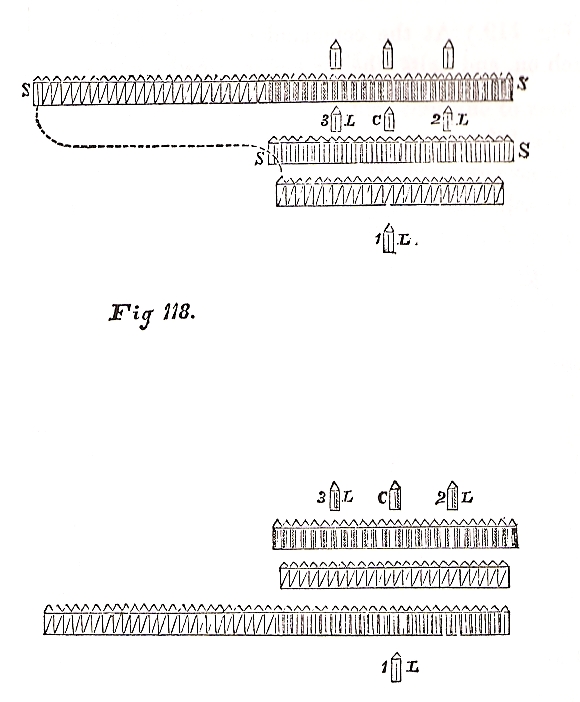

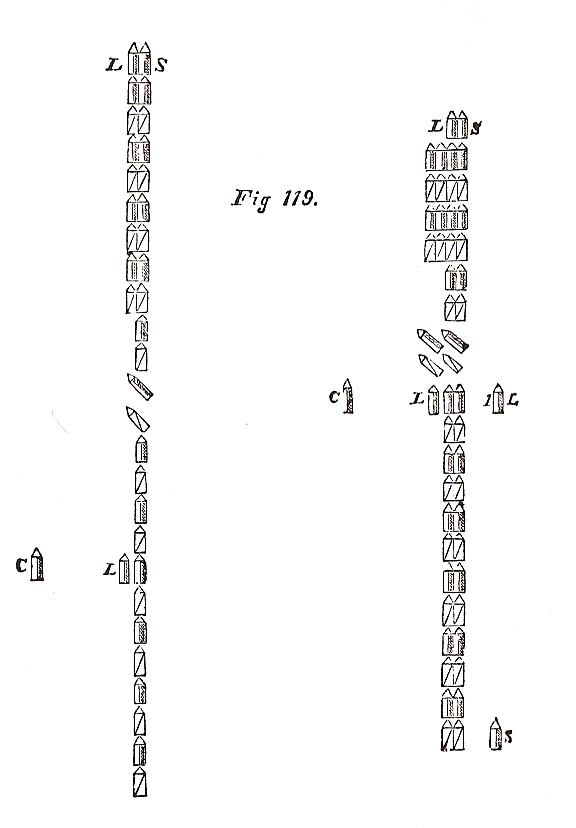
























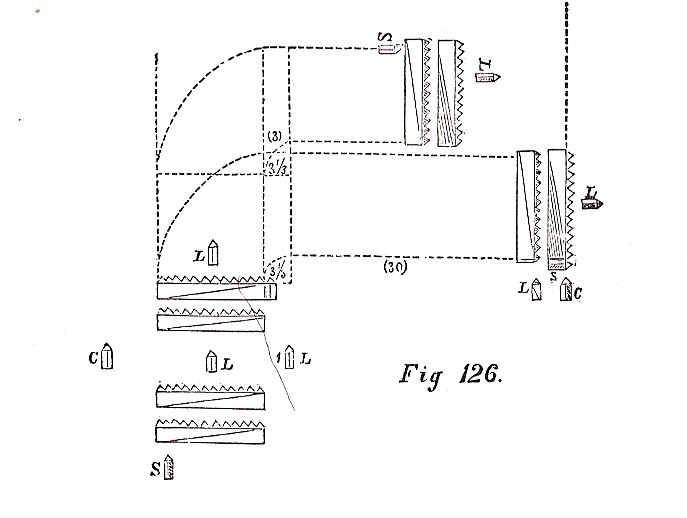


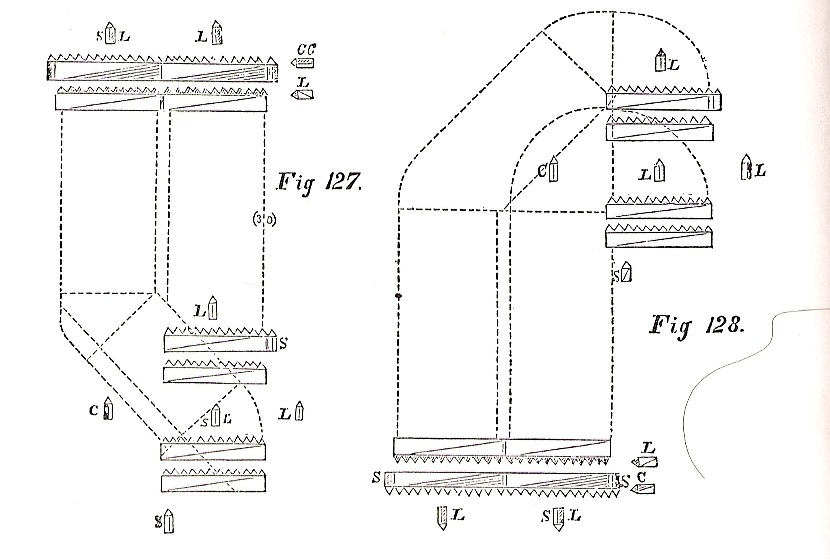



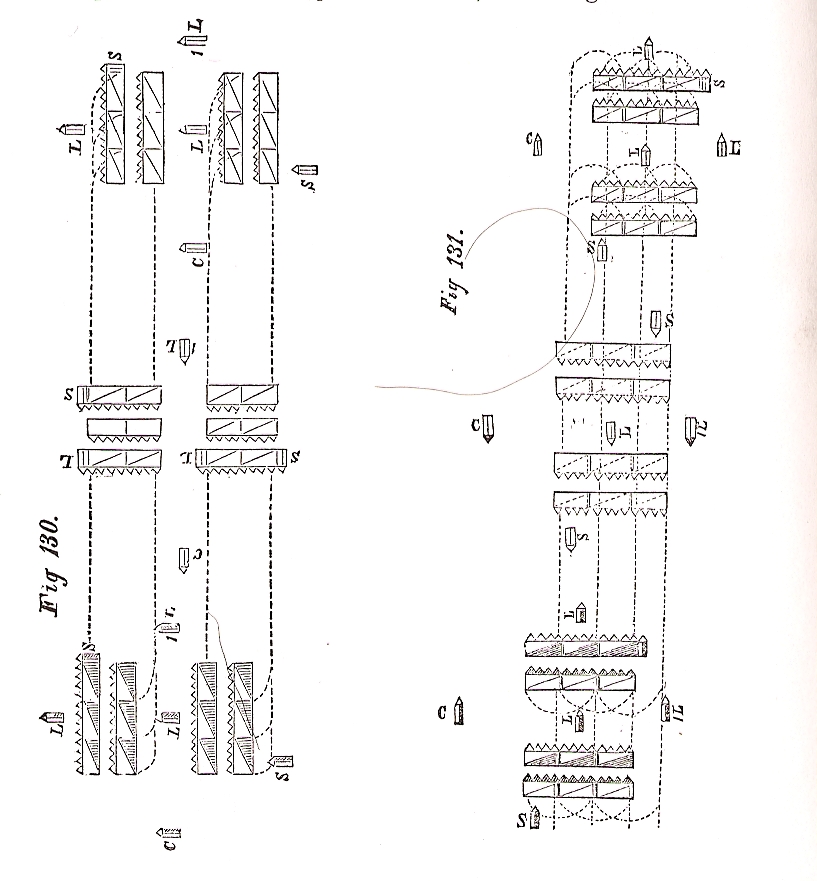





 same manner at the trot, and at the the gallop.
same manner at the trot, and at the the gallop. 



